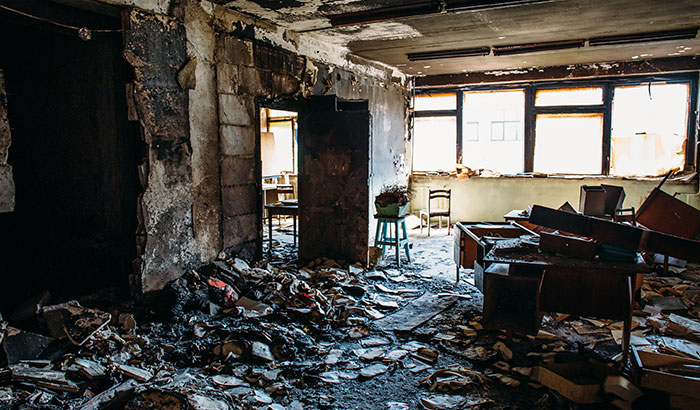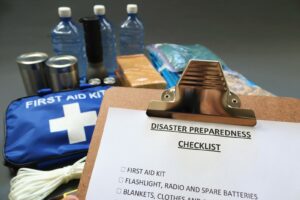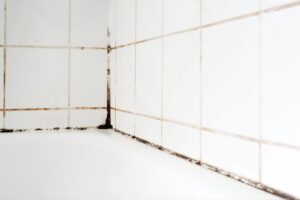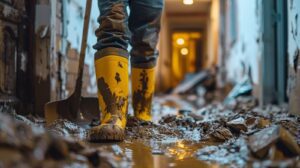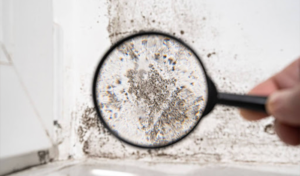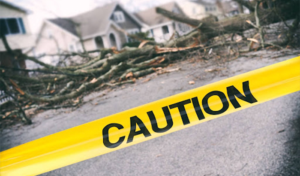Smoke and fire are two distinct forms of damage that can occur in a fire event. Smoke damage refers to the residue and discoloration caused by smoke that can penetrate materials. On the other hand, fire damage refers to the direct damage caused by the fire itself.
In this article, we’re taking a closer look at these damages and what harm they can do to your home. Let’s take a look.
FIRE – What Is Fire Damage?
Fire damage can cause a lot of destruction to a home. Some of the most common forms of fire damage include:
- Structural Damage – Fire can cause structural damage to a building, including the burning or melting of beams, walls, and roofs. In severe cases, a fire can completely collapse a structure.
- Destruction of Objects and Materials – Fire can destroy furniture, electronics, appliances, clothing, and other personal belongings. In many cases, these items cannot be salvaged and must be replaced.
- Heat Damage – The intense heat generated by a fire can cause the warping, melting, and cracking of building materials and objects. This can weaken the structural integrity of a building and make it unsafe to occupy.
- Smoke Damage – Smoke and soot can penetrate walls, floors, and other surfaces, causing discoloration and lingering odors. This damage is often the most difficult to clean up and may require specialized cleaning methods.
- Water Damage – Firefighters use water to extinguish fires, and the water can cause significant damage to a building and its contents. This damage can include the warping and swelling of building materials and mold growth.
- Electrical damage – Fire can cause electrical systems, such as wiring, switches, and outlets, to fail. This can pose a safety hazard and might require extensive repairs or replacement.
- Health hazards – Fire can release toxic fumes and chemicals that can harm human health. This can include exposure to carbon monoxide, particulate matter, and other hazardous substances.
What Causes Fire Damage?
The rapid oxidation of materials causes damage during a fire, which releases heat, light, and gases. Many factors can contribute to the start and spread of a fire, including:
- Ignition Sources – A fire needs an ignition source, such as a spark, an open flame, or a heating element. Common ignition sources include electrical malfunctions, smoking materials, and kitchen accidents.
- Fuel – Fires need fuel to sustain themselves, such as wood, paper, gasoline, oil, and other flammable materials. The amount of fuel present and its flammability will determine the size and intensity of a fire.
- Oxygen – Fires need oxygen to continue burning, and the presence of oxygen will determine the speed and intensity of a fire.
- Heat – The heat generated by a fire can cause the temperature in a room or building to rise, which can cause additional materials to catch fire and contribute to the spread of the fire.
- Ignition time – The amount of time it takes for a fire to ignite and start spreading will depend on the ignition source, the amount of fuel present, and oxygen.
- Ventilation – The presence of ventilation in a room or building can affect the spread of a fire by providing additional oxygen and allowing heat and smoke to escape.
- Fire suppression systems – The presence of fire suppression systems, such as sprinklers, fire alarms, and fire extinguishers, can help prevent or limit the spread of a fire.
- Building Construction – The construction of a building, including the materials used and the presence of fireproofing and fire barriers, can affect the spread of a fire and the level of fire damage.
What Is Smoke Damage?
Smoke damage can have a wide range of effects on a home and can be persistent and difficult to clean up. Some of the most common forms of smoke damage include:
- Discoloration and Staining – Smoke can cause discoloration and staining of walls, ceilings, and other surfaces, making it difficult to restore them to their original condition.
- Lingering Odors – Smoke can penetrate deep into materials and cause a persistent and unpleasant odor that can be difficult to eliminate. This can include the smell of burning plastic, wood, or other materials.
- Corrosion and Etching – Smoke can cause corrosion and etching of metal surfaces and fixtures, such as light fixtures, kitchen appliances, and bathroom fixtures.
- Health Hazards – Smoke can contain toxic and harmful substances, such as carbon monoxide, particulate matter, and other chemicals. These substances can pose a health risk to home occupants, especially if they are exposed to smoke over an extended period.
- Electrical Damage – Smoke can cause electrical systems and components to fail, including wiring, switches, and outlets. This can pose a safety hazard and could require extensive repairs or replacement.
- Damage to HVAC Systems – Smoke can penetrate heating, ventilation, and air conditioning systems, causing damage and reducing efficiency. This can also contribute to lingering odors and health hazards.
- Reduced Indoor Air Quality – Smoke can reduce indoor air quality, making it difficult for residents to breathe comfortably. This can also contribute to respiratory problems and other health issues.
SMOKE – What Causes Smoke Damage?
Smoke damage is caused by releasing particulate matter, gases, and other substances into the air due to burning materials in a fire. Some of the factors that can contribute to smoke damage include:
- Type of Fire – Different types of fires, such as wood, electrical, and oil, produce different types of smoke, each with its unique set of characteristics and potential health hazards.
- Intensity of Fire – The intensity of the fire will affect the amount of smoke produced and the degree of damage that can result. High-intensity fires will produce more smoke and cause more widespread damage than low-intensity fires.
- Burn Time – The length of time that a fire burns will affect the amount of smoke produced and the degree of damage that can result. Longer burn times will produce more smoke and cause more harm than shorter burn times.
- Ventilation – The presence of ventilation in a room or building can affect the spread of smoke by allowing it to escape into other parts of the structure.
- Building Materials – The type of materials present in a building, such as wood, plastic, or synthetic materials, will affect the type and amount of smoke produced by a fire.
- Fire Suppression Systems – The presence of fire suppression systems, such as sprinklers, fire alarms, and fire extinguishers, can help prevent or limit the spread of smoke.
- Building Construction – The construction of a building, including the materials used and the presence of fireproofing and fire barriers, can affect the spread of smoke and the level of smoke damage.
Now, it’s time to call a professional: Total Flood & Fire Restoration
If your home has been a victim of either of these destructive forces, you’ll want to contact Total Flood & Fire Restoration. We’ll use our expertise to facilitate your fire and smoke damage cleanup and have your home back to its pre-damaged condition in no time.

